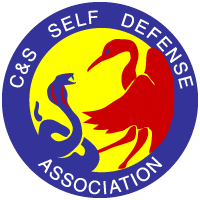
|
C&S Online
An Online Newsletter For The
C&S Self Defense Association
Spring 2001
Confidence. Fitness. Success.
|
|
Thoughts From The Board of Directors...
|

|

|
Alive & Kicking
Grandmaster Paul B. Dusenbery
|
|
What is Worth Knowing?
As you no doubt realize,
the curriculum you are taught in your martial
arts
classes is a rather full one. Students must be able to execute a
variety
of physical movements under sometimes stressful conditions. They must
also
be able to discuss what it is they are doing, why they are doing it, and
how they would teach it to another student. In fact, understanding how
to
teach well is an area of the Art that I have devoted much of my time to.
My secret of teaching is if a student doesn't "get it" I give lots of
push-ups - just kidding of course. In addition, students below the rank
of
black belt are required to grasp an amazing amount of additional
material
such as the history of martial arts, vital striking areas, the physics
of
karate, and meditation. For black belts, there is a comprehensive set of
activities designed to deepen their Art. This area is currently
undergoing
revision.
As a curriculum developer of our Art as well as in science and the DART
(Defense Awareness Response Training) program, I often ask myself what
is
it that our students should know? What is worth knowing? This is an
especially important question in the information age we live in. There
are
lots of activities that our students are doing. But are they the right
ones? Should our students be exposed to lots of material or should they
try and understand a lessor amount? These are very difficult questions
to
answer.
Much of formal education (classroom centered) has relied upon the
ability
to memorize and recall facts. I remember when I had to memorize the
poem,
"I Am an American" in front of my 7th grade English class. You might
have
recited a soliloquy from Shakespeare or some other poem. Who sailed the
ocean blue in 1492? You probably know the answer. When did the American
Revolution begin? You probably know the answer. Proving my prowess at
memorization on multiple-choice and true/false tests was a major part of
my
K-12 education, as it was for generations before me. That probably
helps
to explain why my generation popularized Trivial Pursuit and is tuning
into
TV's Who Want's to be a Millionaire? in record numbers.
But this emphasis on memorization began to be questioned with the
arrival
of information technologies and the Internet, which resulted in
phenomenal
growth of information in the world. The latest projections I have seen
indicate that the information base of the world is now doubling every
12-18
months. Certainly, not all of this information is accurate, appropriate,
or
applicable but it is available to everyone at the click of a mouse.
Take the History of Martial Arts as an example. Orange belt students are
required to read two books for this requirement - Urban's, The Karate
Dojo
and Haines', Karate's History and Traditions. One could wonder whether
reading these books is now "worth it" in todays environment. I bet that
there is lots of martial arts history out there on the web. Why do we
continue to require these books be read? They are required reading not
because you are expected to recall what the author stated but because
your
sensei can evaluate how deep your understanding of the material really
is.
Information out on the web may or may not be much help here. It is not
the
quantity but the quality of your education that matters. How well do you
grasp what martial arts history is and how it may differ from western
history? Do you understand the "big picture"? Do you see that history
is
NOT a collection of facts to be memorized and recalled at the
appropriate
time but the living, breathing story of humanity - with all its vices,
desires, and creativity and brilliance. This perspective is best
discussed
through the oral tradition - not a written one and certainly not
on-line.
That is why my martial arts programs have instituted oral exams for the
history, vital, and physics areas. This was done well over a decade ago
-
long before the Internet.
Going back to my original question, I would like for each of you to
think
critically what should we be teaching in our programs. What is the
essential knowledge that is vital for each student at each level of
their
training to be exposed to and to hopefully understand? There may be
gaps
in our very powerful curriculum that you may bring to light. Remember
that
the senior black belts in C&S do not have all the answers but we do have
a
sincere desire to share our Art with each and every one of you - an Art
that is deep and ever growing.
Grandmaster Paul B. Dusenbery, PhD holds a 7th Degree Black belt. He began his studies with Grandmaster Rose in 1972. Dr. Dusenbery is a space scientist, writer, lecturer, and is the Executive Director of the Space Science Institute in Boulder, CO. He oversees the Dusenbery Tiger leg of C&S. Grandmaster Dusenbery can be reached at dusenbery@spacescience.org.
Top | Front Page | Board | Featured | Happenings | Views | Back Page | C&S Home
|

|

|
The Dragon's Tail
Senior Master David R. Landers
|
|
A Modest Proposal
The purpose of this article
is to stimulate the readerís thought processes in viewing self-defense theory. It seems counterintuitive to say that skill in blocking has less to do with success in real life encounters than does body positioning, but I have come to be more convinced as time, and experience, goes by. That is not to say that we shouldnít practice blocking and blocking drills. Quite the contrary, it is the skill that we develop in that practice that gives us the confidence to break through our fears of coming into close proximity of our opponent. In addition, blocking is necessary, in some cases, once we have closed with the attacker. My point, however, is that no matter what our speed and skill level may be, the fact is that reaction is always slower than action. And if we stand and prepare to block strikes, kicks, and weapons, we are putting all of the chips on our blocking abilities.
Recently I was asked to teach a seminar on knife and gun defense. I asked the students to visualize an umbrella pointing at them from the center of the knife-wielder. The umbrella represents not where the knife is, but where it might be. This is much like atomic particle theory where things are described in terms of potential positions. The reason for this approach is that, if you are at all familiar with skilled knife fighters, the knife can start in one direction and, almost magically, end up somewhere elseÖand you get cut. With that in mind, I feel that the practical approach is not to concentrate on the knifeís position, but on where it can be. So how do you defend yourself from this umbrella of possibility? The answer is to push through the threat. Now thatís harder to do than it is to talk about, but let us see why itís a better idea than to stand and try to block.
A knife is at itís best when it is wielded at armís length. It is easier to cut and thrust when there is sufficient room between you and your target to allow broad arm swings that have real cutting power. If your opponentís body is crushed into your torso, these cuts are not possible, along with most thrusts. Reverse grip raking or drawing cuts are best attempted with the target closer than cut and thrust distance but again are difficult with the opponent very close in and especially with him between your arms. At this point you are probably saying that you can see many ways for the knife to be used on some one up close, but that is if you have to time to reposition yourself for those cuts and to deliver them. I hold that the proper defense, when escape is not an option, is a quick breakthrough of the area of cutting potential, and a delivery of crippling strikes before additional cuts can occur. Notice I said additional. I strongly feel that cuts must be anticipated. A great deal of the shock value of a cut is its surprise. If cuts are anticipated, they can be temporarily ignored.
My preferred method is to jump in with head down, arms forward in a modified boxer position, protecting the neck and face. You must go completely in, torso to torso. It is only from such a close in position that the cutting hand an arm will be compromised in their ability to do damage. Your attack should be to the throat and eyes, they should be a hard and as rapid as possible and, depending on your situation, the opponent should be finished or you should jump out as fast as you came in. Again, I know how hard if is to break through the fear of the knife, but the alternatives are not very pleasant either. Frequently a knife fighter moves in to attack and does so with deliberate slowness, inviting a block so that the blocking hand can be cut. The knife fighter knows about the effects of shock, bleeding, and adrenaline dumping. He knows that if the waits long enough that you will weaken and he can finish the job. Remember, if you are standing there blocking, he has a good idea of your potential positions and can adjust his body and arm movements to his advantage. If you jump into his bubble, he must react. The hardest thing to hit is something moving right at you. Also he must maintain his footing. These factors combine to give you the best advantage you can get against someone who has a knife.
I havenít mentioned kicking but I do think it has its place here. But remember, he has probably been kicked at before and the arteries of the inner thigh are enormous and you donít want them to get into the knifeís range. Keep your kicks low and use them to set up your movements.
You may not agree with me, but at least think about this approach. I prefer the inside and I have always urged students to close with attackers quickly. I always tell them what I learned about horses. If you want to get kicked by one walk about four feet away from them. If you donít want kicked, keep your hip against them at all times. Something to think about.
Master David R. Landers holds a 6th Degree Black belt. He began his studies with Grandmaster Rose in 1969. He served as Deputy Chief of Police of Effingham, Illinois from 1997 to 2000 when he assumed the role of Illinois State Field Coordinator for the Midstates Organized Crime Information Center. He oversees the Landers Dragon leg of C&S. Master Landers can be reached at landers@effingham.net.
Top | Front Page | Board | Featured | Happenings | Views | Back Page | C&S Home
|
Website design by Peter Rose, zzrose@yahoo.com
|


